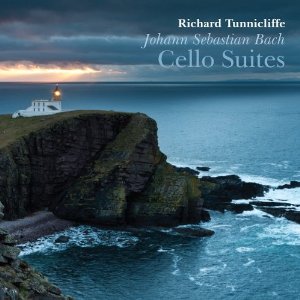| 
Support
us financially by purchasing this disc from |
|
|
|
|
|
Johann Sebastian BACH (1685-1750)
Cello Suites: No. 1 in G major BWV 1007 [18:25], No. 2 in D minor BWV 1008 [20:25], No. 3 in C major BWV 1009 [22:41], No. 4 in E flat major BWV 1010 [23:06], Suite No. 5 in C minor BWV 1011 [25:30], Suite No. 6 in D major BWV 1012 [27:06]
Richard Tunnicliffe (cello)
rec. St George’s Church, Chesterton, Cambridge, UK, 12-16 October 2010, 14-16 February 2011, 21 November 2011.
LINN CKD 396 
[61:56 + 75:56]
There are numerous recordings of the Bach Cello Suites, and for many
cellists these works provide a lifetime journey of musical discovery.
As well as an accomplished cellist, Richard Tunnicliffe is a viol
player and a member of the ensemble Fretwork. As one would perhaps
expect from a player with such an active interest in baroque repertoire,
this recording comes across as honest and historically informed. It
is free of the excessive rubato that can sometimes take over in solo
instrumental works of this kind. That is not to say that the performances
on this two disc set are unexpressive; far from it, in fact. Tunnicliffe’s
reading allows Bach’s melodies to flow and develop naturally
with a sense of unforced simplicity and direction. The sound is clear
and the recording quality is excellent, with the intimacy of chamber
music well captured.
Tunnicliffe’s relatively moderate tempos allow the music to
breathe naturally, with his rich tone resonating beautifully in this
well engineered recording. Tunnicliffe seems to have an innate understanding
of the line, providing a sense of effortless flow to each phrase.
This well considered interpretation is unencumbered by the technical
aspects of the performance. His command of the music and of his instrument
is such that any challenges of technique are never perceptible by
the listener.
The cello sound in this recording is rich and resonant but with a
sense of direct focus in the centre of the tone. Tunnicliffe plays
on a German cello made in 1720, the same year as the cello suites
are thought to have been composed. Also worthy of note is the use
of a five string cello from 1726 for the final, most virtuosic of
the six Suites. Both instruments are heard at baroque pitch.
Tunnicliffe’s well written sleeve-notes describe the music with
authority and enthusiasm, and the dance styles, as well as the performer’s
approach to interpretation, are well explained.
This is a thoroughly engaging recording and one which demonstrates
mastery of the instrument and the chosen repertoire.
Carla Rees
Previous reviews: Brian
Wilson ~~ Mark
Sealey
Masterwork Index: Cello
suites
 |
 |
|
